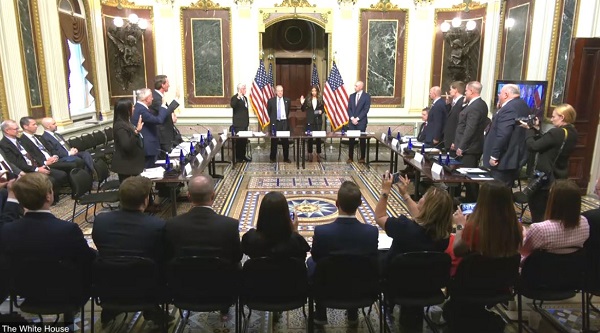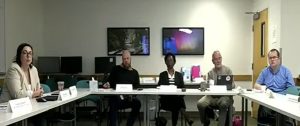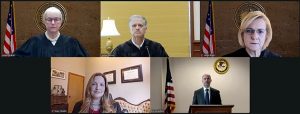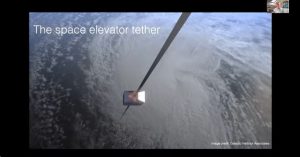Council launches effort to ‘reimagine’ FEMA
10 min read
Presenter: A review council starts looking at the Federal Emergency Management Agency. At its inaugural meeting May 20, FEMA Review Council Co-chair and Secretary of the Department of Homeland Security Kristi Noem:
Kristi Noem: The president has said to me many times that he believes that FEMA should be eliminated as it exists. So what that means is: I need you to reimagine this agency.
[00:00:24] If we do what the president has tasked us to do, I believe this agency needs to be renamed. I do. It’s the Federal Emergency Management Agency, and our goal is that states should manage their emergencies and we come in and support them and we’re there in a time of financial crisis.
[00:00:41] So think about that and what would be a more appropriate name for this agency that really reflects what its responsibilities are and how we’re going to support disaster response on into the future.
[00:00:54] Presenter: She praised the members of the Council. Kristi Noem:
[00:00:58] Kristi Noem: And I want to remind everybody that everybody is at this table and appointed to this council at the specific request of the president of the United States. He has asked for you to be here individually because he recognizes your experience, your insight, and your problem-solving skills are exactly what we need to make sure that this federal agency is going to be a different type of responder in the future.
[00:01:22] Presenter: Deputy National Security Advisor Alex Wong:
[00:01:25] Alex Wong: Congratulations on all of you for being here. It is an honor, but it’s also a very heavy responsibility to reform FEMA and to implement the president’s vision here. He’s chosen you all, I think most importantly, for your bias for action, and that is a bias that the president shares with all of you. He is not one to be complacent.
[00:01:45] He did not want to be on autopilot with FEMA where it continued along the road that it has in a way that did not serve the American people. He wants a structure of FEMA, as the secretary had stated, that empowers state and local authorities, it doesn’t hinder them, doesn’t make them dependent.
[00:02:04] He wants partnership with state and locals, again, not dependency. And he wants a FEMA that fosters innovation, brings in new technology, AI, to really help in disaster prevention as well as response.
[00:02:18] And his metric here is not the amount of money that is pushed out the door, but the number of lives saved and the number of livelihoods protected.
[00:02:28] Presenter: Texas Gov. Greg Abbott:
[00:02:30] Gov. Greg Abbott (Texas): I think during my time as governor of Texas, Texas has had more federally-declared disasters than any other state and second place may not be close.
[00:02:40] So we’ve had a tremendous amount of experience with FEMA. We’ve seen the good and the bad and the ugly. The bottom line is this:We have to streamline the effort… FEMA is slow and clunky and doesn’t solve the needs of those who need it the most and deliver what is necessary. States have proven that we can move more nimbly, more swiftly, more effectively.
[00:03:05] Presenter: From the White House Office of Intergovernmental Affairs, Alex Meyer:
[00:03:09] Alex Meyer: We need to make sure that we are getting ourselves into a more resilient nation. I don’t think that this is something that’s going to be happening overnight. I think that it’s a process. But I think that as states we’ll be successful in this if we charter a path here to establish a way that states are drawing down less from the federal government.
[00:03:27] Because if we set the expectation that every time that there’s a disaster, you’re going to rebuild that same home in the same location in the same place, I think that people are going to start building a more resilient thing. I think that building codes are going to change.
[00:03:40] I think Florida and Texas have done a wonderful job in terms of when a storm has hit, obviously there’s things that are out of their control, but we’re not seeing the same flooding, we’re not seeing the same disasters because they’ve changed the way they’ve done things. And I think that’s an important thing that we can work on here.
[00:03:53] And I think that the best thing that I can emphasize from our role is making sure that we are encouraging states and working with states to be more resilient in their own mind, but also expectation-setting that the federal government isn’t here to be a piggy bank.
[00:04:09] Presenter: Virginia Gov. Glenn Youngkin:
[00:04:11] Gov. Glenn Youngkin (Virginia): I think the scope of the mission can be summarized that we have a broken system and we have to fix it, and it’s kind of that simple. But I do believe that the system is incredibly complicated and it stretches to mitigation up front, to preparation before an emergency event, to lifesaving actions when that event occurs, to immediate stabilization to help people get their power on and their phones turned back on and emergency response around pharmaceuticals that they may need or health care and then we get into long-term recovery and that spectrum has a whole different set of needs and wants depending on where you are.
[00:04:58] We need to understand who’s responsible for what, when, and most importantly, who’s going to pay for it. And the certainty around that process, I think, will lead us to some very clear conclusions: One, the states are ready, we’re ready. I believe there are best practices that should be demanded out of the states.
[00:05:22] I think second of all, we also need to recognize that who going to pay and how much are they going to pay ends up being an inhibitor. And so clarity is so important: How much are the states responsible for, how much is the federal government going to kick in, and how do we have certainty of what that amount is so that we can be ready?
[00:05:46] Because the bureaucracy associated with filling out literally stacks of paper over months and months and months when there is a family that doesn’t have a home is just mind-numbing. But it’s also just completely, completely despondent-causing by those folks who are looking for help. We’ve got to fix this so that we can move quickly.
[00:06:12] And then I think finally, and I don’t know how we get at this in this Council, but emergency management and emergency response at the federal level extends far beyond FEMA. And we find ourselves today in many conversations with USDA to EPA to Commerce to the Small Business (Administration) all the way through to the Department of Transportation and it’s all engaged in emergency response, and oftentimes it’s codependent, and other times it just flat conflicts.
And so if there is an opportunity for us to wade into this quagmire of multiple agency responsibility and departments, then I think we could make some huge progress.
[00:07:01] On June 1 we start hurricane season. And we will be having our normal tabletop exercises in Virginia to get everyone ready for hurricane season and yet we’re going to be changing the tires on this car while this car is barreling 100 miles an hour down the freeway and so we also have to take into consideration the fact that we are going to be massively transforming a response system while that response system has to be effectively responding.
[00:07:34] Presenter: Florida’s Emergency Management Director Kevin Guthrie:
[00:07:38] Kevin Guthrie (Florida Division of Emergency Management, director): We are number one in receiving EMAC, that mutual aid assistance in the United States. No one takes more mutual aid assistance than the state of Florida does and why do we do that? We do it because it’s the lowest price point. It is the best bang for your buck. It is, without a doubt, and you get individuals that actually know what they’re doing. You get individuals that understand government work.
[00:08:03] After that, our number two issue is that if you heard about putting the private sector in place, we have over a dozen preposition contracts in the state of Florida. How do we build roads in eight hours? How do we build bridges in three days? How do we build superstructures in 21 days? How do we remove all debris in a disaster that hit not once, not twice, but three times in this last year? And how do we do that in less than 90 days? Because we do it 24/7. We don’t just pick up debris from 8 a.m. to 5 p.m. We don’t pick it up when there’s daylight outside. We do it 24/7/365 until it is gone.
[00:08:44] We make decisions in Florida based on not if we’re going to get reimbursed, but we base it on our GDP (gross domestic product). We know that we’ve got to get people back to our beaches. We know we’ve got to get people back to The Mouse (Walt Disney World). We know that we got to get people back to tourism in the state of Florida. Our average GDP per city is about $36.5 million a day. So that’s why we invest in getting our stuff back up and running as quickly as we possibly can.
[00:09:11] We talked about building codes. Florida has the strongest building code in the country, if not maybe the world. Florida building code works. We invest in that. We believe in it. We can take you up and down our beaches, up and down our state, where we show houses that are still working or still unaffected.
[00:09:30] I think some of the things that I’d like to see come out of this is standardization. We’ve invested over $20 million in technology in Florida in getting stuff done. We are the first in the country to our knowledge to actually engage generative AI on auditing our records. That starts from standardization.
[00:09:52] Presenter: Director of the Texas Division of Emergency Management, Nim Kidd:
[00:09:57] W. Nim Kidd (Texas, Division of Emergency Management, director): All disasters are local. Everything begins and ends at the local level. And so over that 20-year time period of dealing with FEMA from (Hurricane) Katrina on, I’ve had my fingers in every disaster in our state. Many times, Governor, I have more auditors on our team than actual people writing plans, doing training, doing exercising, or out servicing others in recovery and mitigation. We’ve got to change that process. That has to change.
[00:10:22] Presenter: He led recovery efforts in Louisiana after Hurricane Katrina. Mark Cooper:
[00:10:27] Mark Cooper (Louisiana): As we approach the 20-year anniversary of Hurricane Katrina, FEMA again is at a critical juncture for significant and transformational change as you discussed and lined out. Disasters are becoming more frequent, challenging, and complex. And the national level has grown much bigger. FEMA has grown much bigger and more bureaucratic in many of the important programs they administer.
[00:10:49] And despite this, I’m a big supporter of the FEMA regional offices. And they continue to represent and support the states so that we can be effective. As we study these issues, we should also determine what programs at the national level are essential and get back more to the coordination role that FEMA (or whatever the agency becomes) served initially, the coordination, and push that down to the regional and to the state levels.
[00:11:15] We also need to see what changes need to be made to the Stafford Act and other laws that promote timely and reasonable decisions that are needed to speed up the recovery process.
[00:11:25] Presenter: FEMA Review Council Co-chair Kristi Noem:
[00:11:28] Kristi Noem: The president and I have had many, many discussions about this agency. Let me be clear about the future of this agency. The president wants it to be eliminated as it exists. So I don’t want you to go into this thinking that we’re going to make a little tweak here, a little delegation of authority over here, that we’re going to maybe cut a few dollars somewhere.
[00:11:48] No, FEMA should no longer exist as it is. He wants this to be a new agency, something that understands its role in emergency response. That is our direction from the president of the United States. And as we go forward, everything will be viewed from that lens.
[00:12:06] What still needs to be done, what’s a responsibility that we have, and what can we do to make sure that states have the authority to better take care of their people? Right now, we tie their hands, and it’s a dereliction of duty to say that ‘We’re responsible for this, we’re responsible for this,’ when the people who can do it better are right there on the front lines. They’re the people that are right there and have the knowledge and wisdom to do it.
[00:12:29] I think if we do the deployment of dollars quicker in a state block grant to the states, then it will get deployed to people much quicker and we can have those claims wrapped up in a timely manner that’s much more responsible.
[00:12:43] In the discussions that I’ve had, you know, the will is to get claims paid within six months, at the very latest, nine to ten months. That would be historical change for this agency. Right now, we could wait six months or have under the last administration for even a declaration to be approved.
[00:13:02] And so we have to move faster, deploy resources, but we also need to empower states to act without waiting for the federal government to give them direction.
[00:13:12] Presenter: The FEMA Review Council held its first meeting May 20, which started the clock. According to the executive order, the council now has 180 days to deliver its report, which includes ‘an evaluation of whether FEMA can serve its functions as a support agency, providing supplemental federal assistance to the states, rather than supplanting state control of disaster relief.’






